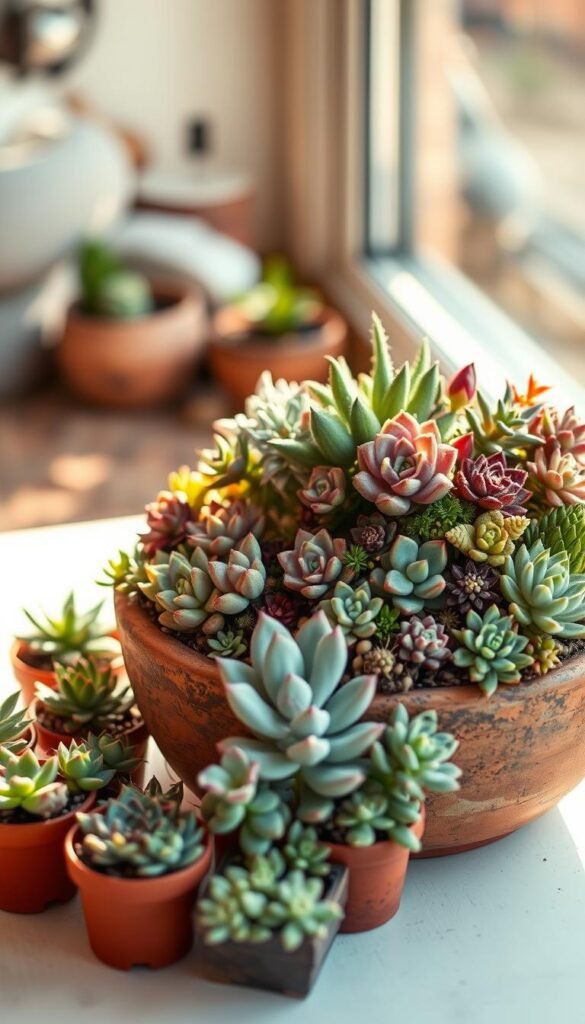Discover how desert plants can breathe new life into forgotten containers. These low-maintenance wonders thrive in small spaces, letting you craft eye-catching displays without demanding hours of care. Their water-storing leaves make them perfect for busy lifestyles, adapting to everything from sunny windowsills to cozy office corners.
Your creativity takes center stage here. Transform vintage teacups, cracked bowls, or even weathered boots into living art pieces. Mix textures and colors by pairing spiky varieties with rosette-shaped types, creating visual contrast that evolves over time. The secret lies in choosing plants with similar light needs – nature handles the rest.
These arrangements do more than beautify your home. They bring a slice of Earth’s resilience indoors, reminding you of growth even in challenging conditions. Best part? You’ll spend less time watering and more time admiring your handiwork as it matures.
Ready to start? You’ll need just three things: a container with drainage, fast-draining soil, and your favorite succulents. The process feels more like play than work, offering instant gratification with lasting rewards. Whether you’re a first-timer or seasoned gardener, these projects invite you to reconnect with nature through simple, satisfying crafts.
Innovative Upcycling Inspirations for Your Succulent Dish Garden
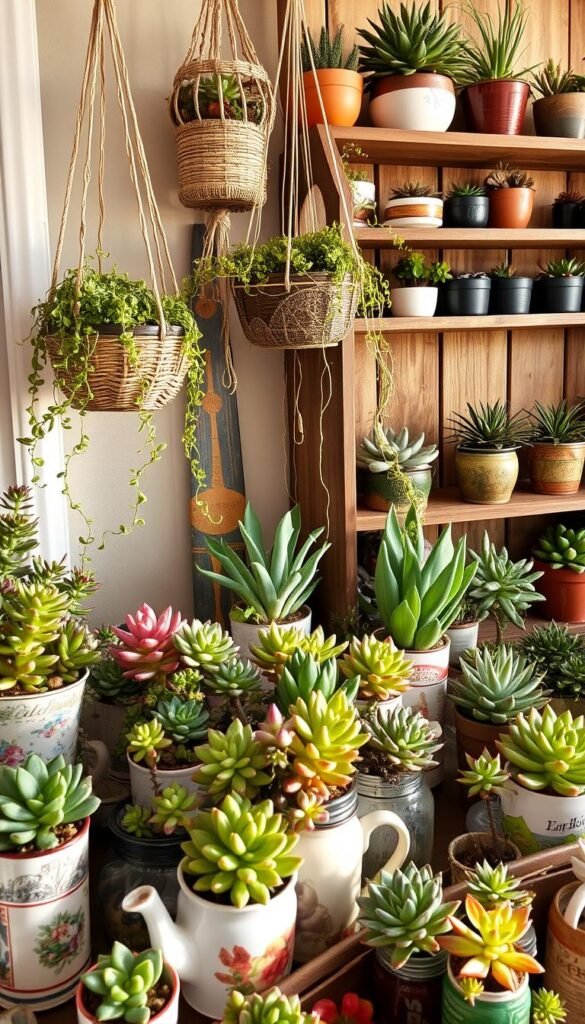
Unleash creativity by turning overlooked objects into living masterpieces. That cheese grater collecting dust? It becomes a statement planter with built-in drainage when lined with window screen. Vintage coffee makers and cracked baking dishes transform into conversation-starting homes for your green companions.
Transforming Everyday Items into Planters
Your hunt for unique containers starts in unexpected places. Community crafters have used brake discs as industrial-chic pots and turned Amazon bubble mailers into temporary homes. The key? Choose items with personal meaning – grandma’s chipped teapot or your child’s outgrown rain boots add heart to your display.
Ensuring Proper Drainage and Soil Management
Those natural holes in graters need reinforcement. Secure window screen patches with hot glue at the corners – this keeps soil in while letting water flow out. For solid-bottom containers like soup cans, drill multiple quarter-inch holes using a step drill bit. Always use fast-draining cactus mix, and consider adding a wood base stained dark to hide drainage gaps.
Upcycled planters thrive when you mimic natural desert conditions. Layer pebbles beneath your soil in cookie tins, and use catch trays under delicate items like embroidered tea towels. Your plants will reward you with vibrant growth when their roots stay dry and aerated.
Succulent Dish Garden Ideas: Easy DIY Projects for Plant Lovers
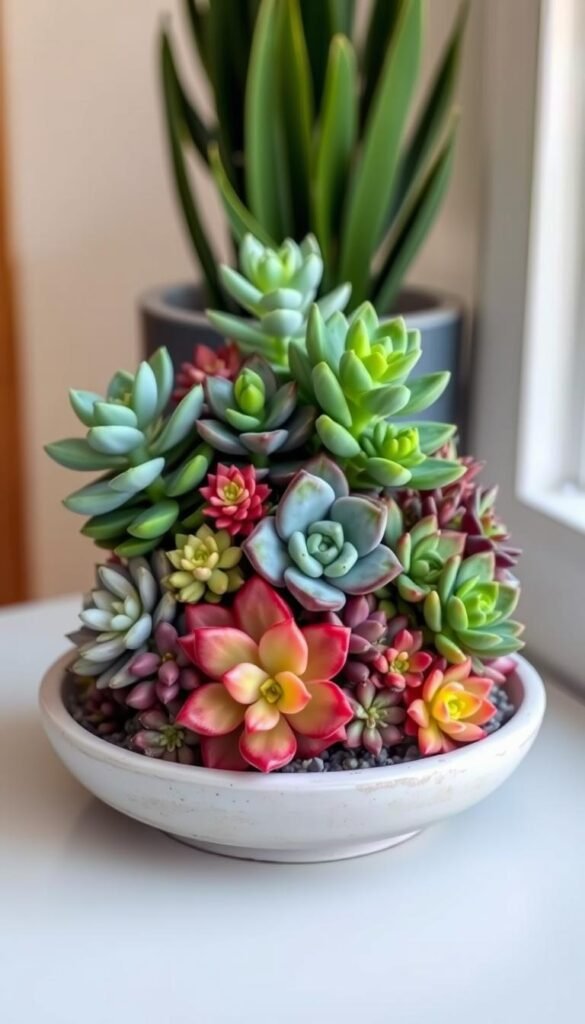
Transform ordinary objects into living decor using simple upcycling methods. With basic tools and creativity, you can convert household items into stunning plant homes. This approach combines sustainability with artistic expression, giving new purpose to forgotten treasures.
Step-by-Step Upcycling Techniques
Start by cleaning your chosen container thoroughly. Check existing holes for drainage potential – a cheese grater’s natural openings work perfectly when lined with window screen. Secure the screen with hot glue at the corners to create a soil-retaining base.
Cut a wood block to fit snugly inside your planter. Stain it dark to prevent light colors from peeking through decorative holes. Fill the container with cactus soil mixed with perlite for optimal drainage.
| Material | Purpose | Pro Tip |
|---|---|---|
| Window screen | Prevents soil loss | Use 2-3 layers for large holes |
| 2×4 wood piece | Creates stable base | Sand edges for smooth finish |
| Floral wire | Secures tall stems | Wrap gently around stems |
Choose plants that complement your container’s size. Tall varieties like Portulacaria afra add vertical interest, while colorful Sedums bring vibrant contrast. Insert cuttings directly into dry soil – they’ll root naturally over time.
Rotate your project as you work to ensure balanced visuals from all angles. Use floral wire temporarily to hold taller stems in place. Within weeks, your upcycled creation will develop into a self-sustaining display of natural beauty.
Guide to Creating Unique DIY Planter Designs
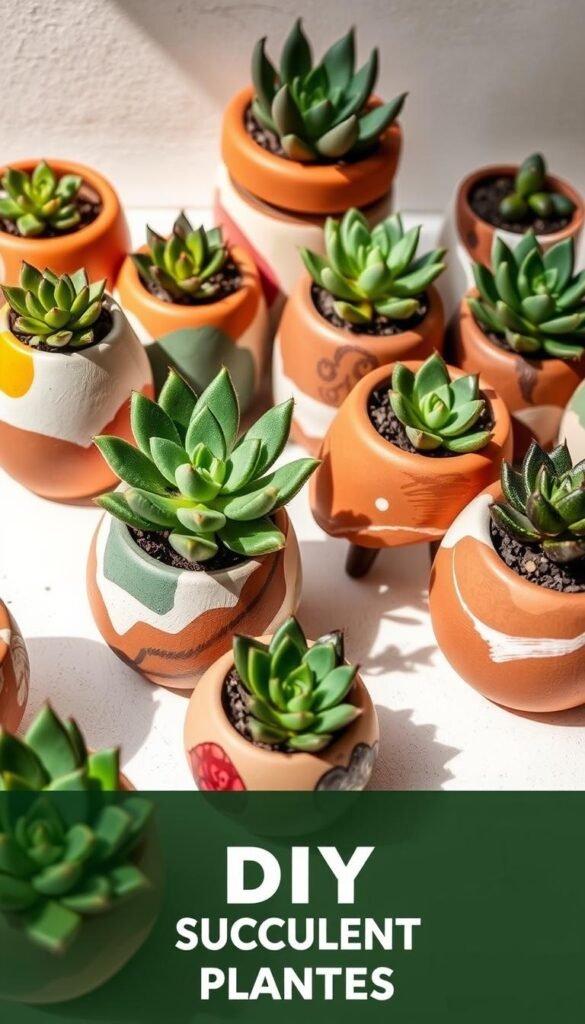
Personalize your space by transforming basic containers into living art. Start with non-toxic acrylic paints – they’re safe for kids and dry quickly on most surfaces. Masking tape creates crisp geometric patterns, while permanent markers add playful details like polka dots or cartoon faces.
Painting, Decorating, and Finishing Touches
Elevate thrifted pots using three simple tools: painter’s tape, metallic spray paint, and a steady hand. Create ombre effects by blending colors from dark to light. For animal-themed planters, use Sharpies to draw whiskers on mason jars or googly eyes on recycled tin cans.
| Material | Use Case | Drying Time |
|---|---|---|
| Chalk paint | Vintage finishes | 1 hour |
| Acrylic markers | Detailed designs | 15 minutes |
| Washi tape | Temporary patterns | Instant |
Top dressings complete your design. Try crushed sea glass for coastal themes or cinnamon sticks for rustic charm. These layers help soil retain moisture while adding visual texture.
Using Alternative Materials for Creative Flair
Twine-wrapped containers pair beautifully with spiky varieties. Try printable temporary tattoos on smooth ceramic pots – they last months outdoors. Popsicle sticks make charming labels when painted with weatherproof sealant.
Broken pottery pieces become mosaic accents along planter rims. For cohesive arrangements, repeat one color across multiple pots using spray paint or ribbon ties. Your creations will showcase personality while keeping plants healthy and thriving.
Family-Friendly Succulent Projects to Enjoy Together
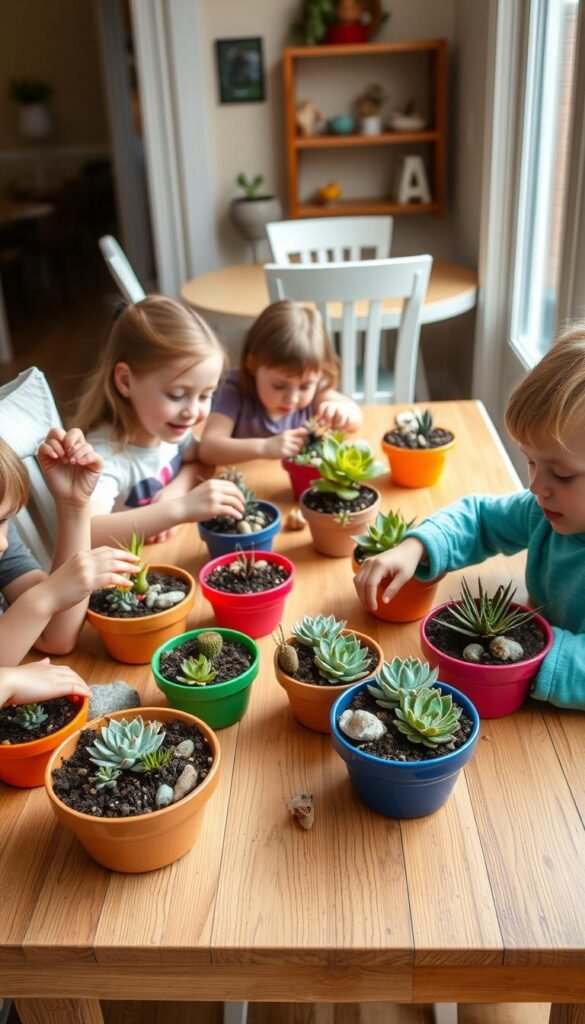
Spark curiosity in young minds by blending nature exploration with hands-on creativity. These activities turn ordinary materials into living classrooms where green companions become playful teachers.
Creative Planting Adventures
Transform empty egg cartons into science labs. Kids place healthy leaves in compartments, misting weekly to watch new growth emerge. This simple step-by-step process teaches patience and plant life cycles in action.
Whimsical Creature Containers
Turn plastic bottles into grinning hedgehogs or wide-eyed owls. Help children draw animal shapes, then cut carefully with safety scissors. Non-toxic acrylic paints bring personalities to life while creating functional pots with drainage.
| Project | Materials | Learning Focus |
|---|---|---|
| Propagation Station | Tray, leaves, spray bottle | Growth observation |
| Animal Planters | Bottles, scissors, paint | Recycling & design |
| Plant Labels | Popsicle sticks, markers | Species identification |
Make education deliciously fun with interactive labeling activities. Children create colorful markers using construction paper and wooden sticks, drawing leaf shapes while learning plant names. These projects build responsibility through daily care routines.
Friends and families bond while arranging textured varieties in shared containers. Kids practice measuring soil depth and spacing plants properly. The magic happens when tiny hands get dirty – and discover the joy of nurturing life.
Curating Living Art: Succulent Arrangements and Styling Tips
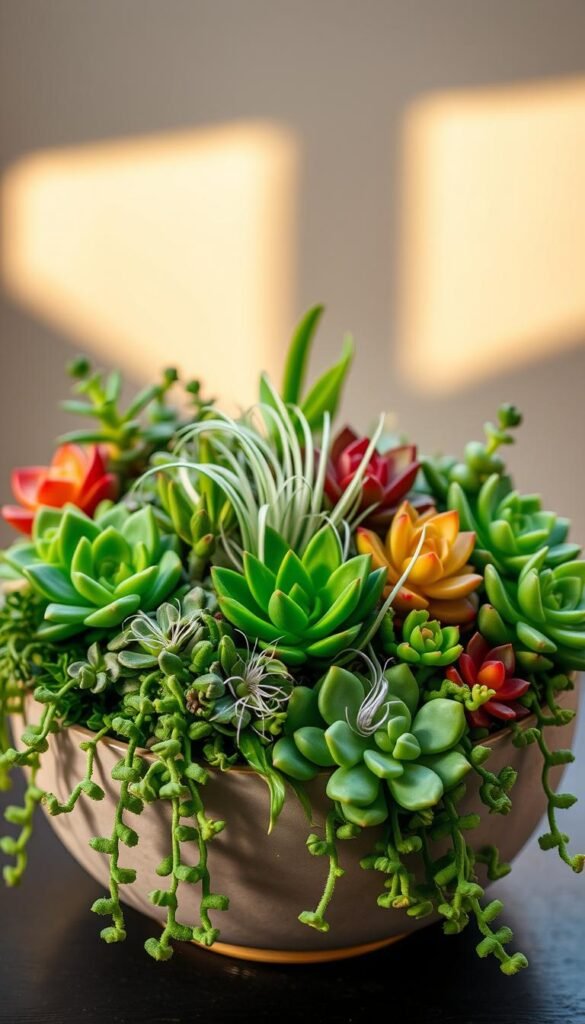
Craft living sculptures that evolve with the seasons using nature’s boldest colors and shapes. These dynamic compositions become centerpieces that transform your space, blending horticulture with artistic expression.
Layering Colors and Textures for Visual Impact
Start with dramatic Aeonium ‘Zwartkop’ as your anchor – its near-black rosettes demand attention. Frame it with golden Sedum nussbaumerianum, whose winter blush adds year-round drama. These striking pairs teach us that contrast creates character in living displays.
Build depth by mixing forms. Place upright varieties like Portulacaria afra behind trailing types such as String of Pearls. This layering technique gives arrangements professional polish while accommodating each plant’s light needs.
| Variety | Color Feature | Design Tip |
|---|---|---|
| Aeonium ‘Kiwi’ | Lime-green edges | Use as bright filler between dark specimens |
| Echeveria ‘Lola’ | Pastel purple tones | Create monochromatic schemes |
| Crassula ‘Campfire’ | Fiery red tips | Adds seasonal color transitions |
Rotate your container as you work, checking sight lines from all angles. Tight planting works beautifully since most varieties grow slowly. Their shallow roots adapt well to dish-style containers, maintaining proportions for months.
Position finished pieces where light enhances their colors – east-facing windows intensify reds and purples. Remember, the vessel contributes to the story. A weathered tray complements rustic arrangements, while sleek ceramics heighten modern minimalism.
Wrapping Up Your Creative Succulent Journey
Your journey into reimagining everyday objects as living art doesn’t end here—it evolves with every container you rescue and every plant you nurture. The upcycling community thrives on shared creativity, proving even brake discs or coffee makers can become thriving homes for green companions. Remember, success lies in balancing imagination with practical care like drainage solutions and soil mixes.
Need inspiration? Explore eco-friendly container gardening methods used by fellow enthusiasts. You’ll discover how 87% of common root issues vanish with proper preparation, and how simple materials like tin cans transform into striking displays. Share your creations with friends to spark new lightbulb moments—collaboration fuels innovation.
Whether crafting solo or hosting planting parties, these projects remind us that beauty grows from resourcefulness. Keep experimenting, stay curious, and let your space bloom with personality. After all, every rescued item tells a story—and now, yours includes thriving greenery.

